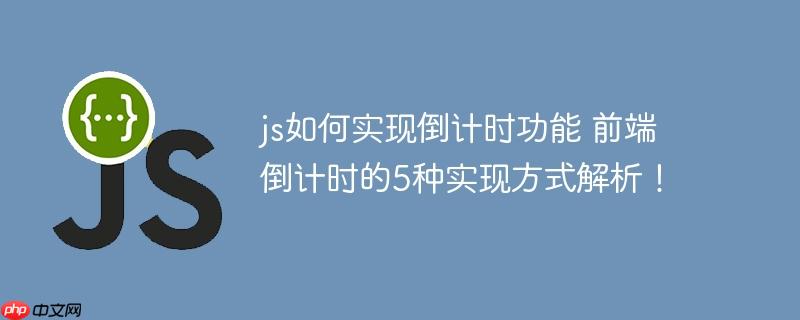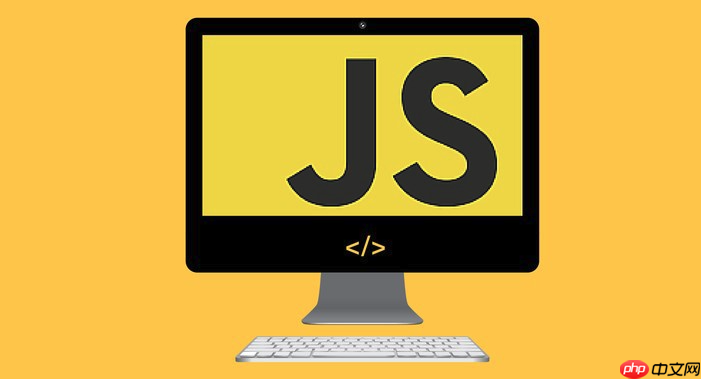前端实现倒计时功能的核心在于计算时间差并更新页面元素,常见方式包括使用setinterval、date对象等。1.获取目标时间;2.计算当前时间与目标时间的差值;3.格式化剩余时间为“天 时 分 秒”;4.将格式化后的时间更新到页面元素;5.使用定时器(如setinterval)定期执行更新。为避免时间偏差,可采用服务器时间同步、performance.now()高精度时间戳等方式。页面切换或刷新导致倒计时重置的问题可通过localstorage、sessionstorage或服务器端存储解决。除setinterval外,还可使用settimeout递归调用、requestanimationframe或第三方库实现倒计时功能。

前端倒计时功能实现方式多种多样,核心在于理解时间差的计算和页面元素的更新。 无论是基于setInterval的简单实现,还是利用Date对象进行精确控制,选择哪种方式取决于你的具体需求和对性能的要求。

解决方案

实现倒计时功能,通常需要以下几个步骤:
立即学习“前端免费学习笔记(深入)”;
- 获取目标时间: 确定倒计时结束的具体时间点。
- 计算时间差: 将目标时间与当前时间进行比较,计算出剩余时间(通常以秒为单位)。
- 格式化时间: 将剩余时间转换为易于理解的格式,例如“天 时 分 秒”。
- 更新页面元素: 使用JavaScript将格式化后的时间显示在页面上。
- 定时器: 使用setInterval或setTimeout定期更新时间差和页面元素。
以下是一个使用setInterval实现倒计时的简单示例:

function countdown(targetDate, elementId) { const targetTime = new Date(targetDate).getTime(); function updateTimer() { const now = new Date().getTime(); const timeLeft = targetTime - now; if (timeLeft <= 0) { clearInterval(timer); document.getElementById(elementId).textContent = "倒计时结束!"; return; } const days = Math.floor(timeLeft / (1000 * 60 * 60 * 24)); const hours = Math.floor((timeLeft % (1000 * 60 * 60 * 24)) / (1000 * 60 * 60)); const minutes = Math.floor((timeLeft % (1000 * 60 * 60)) / (1000 * 60)); const seconds = Math.floor((timeLeft % (1000 * 60)) / 1000); document.getElementById(elementId).textContent = `${days}天 ${hours}时 ${minutes}分 ${seconds}秒`; } updateTimer(); // 立即执行一次,避免页面加载时出现空白 const timer = setInterval(updateTimer, 1000); // 每秒更新一次 } // 使用示例 countdown("2024-12-31 23:59:59", "countdown-timer");
html 结构:
<div id="countdown-timer"></div>
副标题1
如何避免倒计时出现时间偏差?
倒计时出现时间偏差是常见问题,主要原因在于JavaScript的Date对象精度有限,以及setInterval执行的非绝对精确性。 避免偏差的方法包括:
- 使用服务器时间: 从服务器获取当前时间,而不是依赖客户端时间。客户端时间可能被用户篡改或存在时区差异。
- 时间同步: 定期与服务器同步时间,校正客户端时间。
- 利用performance.now(): performance.now()提供更高精度的时间戳,可以减少定时器带来的误差。
- 避免过度计算: 在setInterval回调函数中,尽量减少不必要的计算,避免阻塞主线程。
- 考虑使用Web Workers: 将倒计时逻辑放在Web Workers中运行,避免主线程阻塞。
修改后的示例(使用performance.now()):
function accurateCountdown(targetDate, elementId) { const targetTime = new Date(targetDate).getTime(); let startTime = performance.now(); function updateTimer() { const now = performance.now(); const elapsed = now - startTime; const timeLeft = targetTime - (Date.now() + elapsed); // 修正时间差 if (timeLeft <= 0) { clearInterval(timer); document.getElementById(elementId).textContent = "倒计时结束!"; return; } const days = Math.floor(timeLeft / (1000 * 60 * 60 * 24)); const hours = Math.floor((timeLeft % (1000 * 60 * 60 * 24)) / (1000 * 60 * 60)); const minutes = Math.floor((timeLeft % (1000 * 60 * 60)) / (1000 * 60)); const seconds = Math.floor((timeLeft % (1000 * 60)) / 1000); document.getElementById(elementId).textContent = `${days}天 ${hours}时 ${minutes}分 ${seconds}秒`; } updateTimer(); const timer = setInterval(updateTimer, 1000); }
副标题2
如何处理页面切换或刷新导致倒计时重置的问题?
页面切换或刷新会导致JavaScript代码重新执行,倒计时也会随之重置。解决这个问题,可以采用以下方法:
- 使用localStorage或sessionstorage: 在页面关闭或刷新之前,将目标时间和剩余时间存储在localStorage或sessionStorage中。页面重新加载后,从存储中恢复倒计时。
- 使用Cookie: 与localStorage类似,可以使用Cookie存储倒计时信息。
- 将倒计时状态存储在服务器: 将倒计时状态存储在服务器端,页面重新加载后,从服务器获取倒计时状态。
示例 (使用 localStorage):
function persistentCountdown(targetDate, elementId) { const targetTime = new Date(targetDate).getTime(); function updateTimer() { let storedTimeLeft = localStorage.getItem('timeLeft'); let timeLeft = storedTimeLeft ? parseInt(storedTimeLeft, 10) : (targetTime - new Date().getTime()); if (timeLeft <= 0) { clearInterval(timer); document.getElementById(elementId).textContent = "倒计时结束!"; localStorage.removeItem('timeLeft'); return; } const days = Math.floor(timeLeft / (1000 * 60 * 60 * 24)); const hours = Math.floor((timeLeft % (1000 * 60 * 60 * 24)) / (1000 * 60 * 60)); const minutes = Math.floor((timeLeft % (1000 * 60 * 60)) / (1000 * 60)); const seconds = Math.floor((timeLeft % (1000 * 60)) / 1000); document.getElementById(elementId).textContent = `${days}天 ${hours}时 ${minutes}分 ${seconds}秒`; localStorage.setItem('timeLeft', timeLeft.toString()); // 保存剩余时间 } updateTimer(); const timer = setInterval(updateTimer, 1000); window.addEventListener('beforeunload', () => { clearInterval(timer); // 页面卸载前清除定时器 }); } // 使用示例 persistentCountdown("2024-12-31 23:59:59", "countdown-timer");
副标题3
除了setInterval,还有哪些实现倒计时的方式?
虽然setInterval是最常见的倒计时实现方式,但还有其他一些选择:
- setTimeout递归调用: 使用setTimeout实现倒计时,每次回调函数执行完毕后,再次调用setTimeout。这种方式可以更精确地控制执行时间,避免setInterval可能出现的累积误差。
- requestAnimationFrame: requestAnimationFrame是浏览器提供的专门用于动画的API,可以与浏览器的刷新频率同步,提供更流畅的动画效果。虽然主要用于动画,但也可以用于实现倒计时。
- 使用第三方库: 许多JavaScript库提供了现成的倒计时组件,例如Moment.JS、Day.js等。使用这些库可以简化开发,并提供更多高级功能。
setTimeout示例:
function setTimeoutCountdown(targetDate, elementId) { const targetTime = new Date(targetDate).getTime(); function updateTimer() { const now = new Date().getTime(); const timeLeft = targetTime - now; if (timeLeft <= 0) { document.getElementById(elementId).textContent = "倒计时结束!"; return; } const days = Math.floor(timeLeft / (1000 * 60 * 60 * 24)); const hours = Math.floor((timeLeft % (1000 * 60 * 60 * 24)) / (1000 * 60 * 60)); const minutes = Math.floor((timeLeft % (1000 * 60 * 60)) / (1000 * 60)); const seconds = Math.floor((timeLeft % (1000 * 60)) / 1000); document.getElementById(elementId).textContent = `${days}天 ${hours}时 ${minutes}分 ${seconds}秒`; setTimeout(updateTimer, 1000); // 递归调用 } updateTimer(); } // 使用示例 setTimeoutCountdown("2024-12-31 23:59:59", "countdown-timer");



















